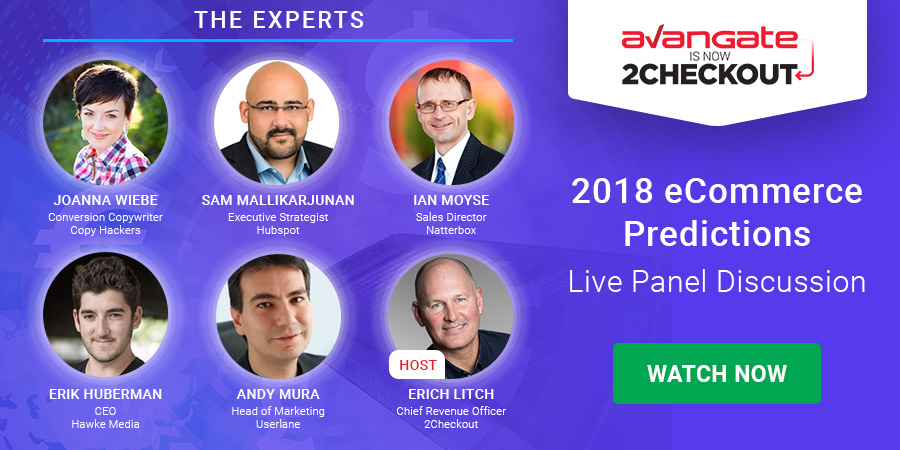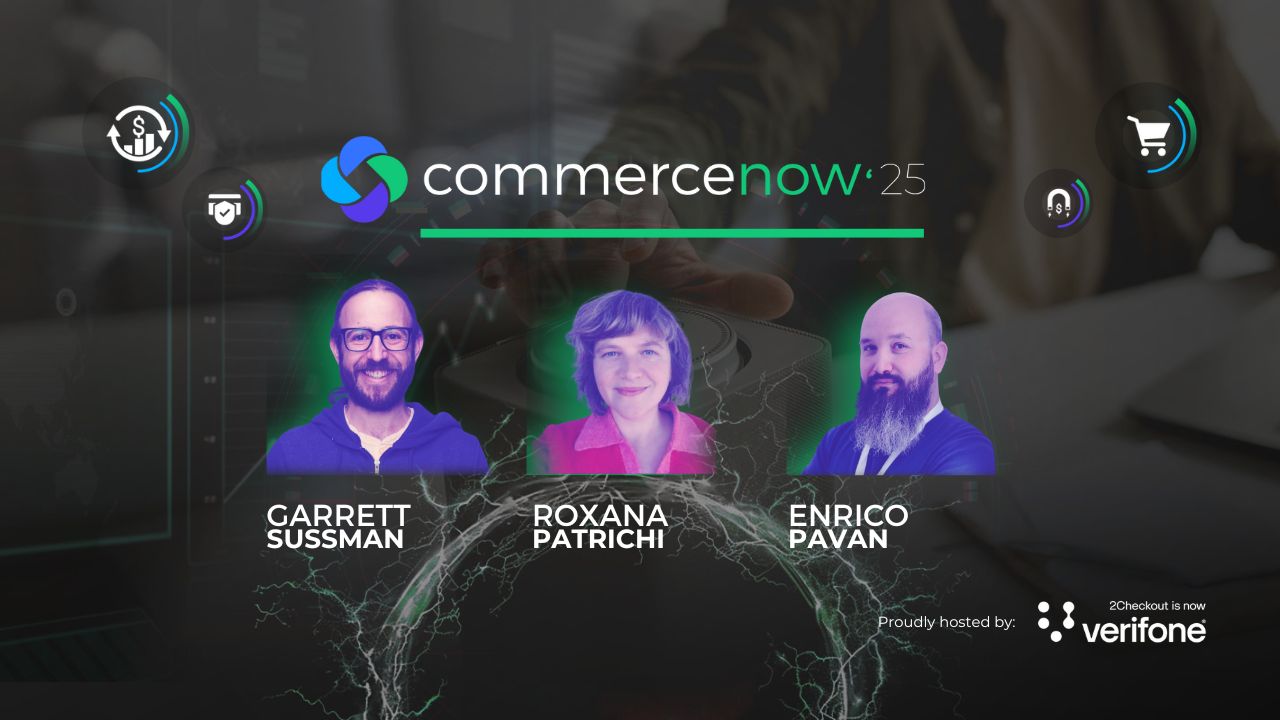We’ve recently had the pleasure to host a panel discussion on eCommerce Predictions for 2018. Erich Litch, Chief Revenue Officer at 2Checkout, moderated the panel of five amazing speakers who shared their thoughts on the broad and exciting topics of eCommerce, marketing, customer acquisition and retention.
Here’s the great line-up of speakers:
Joanna Wiebe, conversion copywriter, creator of Copy Hackers and co-founder of Airstory;
Sam Mallikarjunan, executive strategist at HubSpot, who also teaches marketing strategy and digital media at the Harvard Division of Continuing Education;
Ian Moyse, sales director at cloud telephony provider Natterbox and a technology cloud thought leader;
Erik Huberman, one of the Forbes 30 Under 30, is a founder and CEO of Hawke Media, an innovative full service digital marketing agency; and last but not least,
Andy Mura, head of marketing at Userlane, inbound and content marketer and entrepreneur.
We’ve prepared a set of three questions for the panelists. Each took turns and left their thoughts on each topic. Here’s the transcript of that discussion, chock full of great ideas and – most importantly – actionable tips that you can (and should!) apply to your online business in 2018. Let’s dive right into the first question.

Erich L.: What are the most important trends that businesses should take into account for their digital commerce operations in 2018?
Sam, please kick it off and share your thoughts.

Sam: Well, thanks for having me, I was really excited to hear you say that we’re gonna be talking about retention because I think that’s something that we don’t think about nearly enough in the eCommerce space. We focus on SEO and PPC and spamming our email list three times a week with a coupon and calling that email marketing, and we don’t focus enough on how do we get really good at keeping customers and those customer-centric economics. Price competition with Amazon and everything else has gotten almost as pure as it can get and if that’s your strategy—and don’t get me wrong, I used to work at cheaphumidors.com, we sold humidors cheaply, that was our strategy—but if that’s your strategy in today’s market, you’re not going to be very successful at building an effective long-term business.
So that’s one trend. The other is the departure of the website as the core to the web experience. It used to be that was our main focus but we’ve all seen the spike in traffic from mobile devices, SMS and social media, voice control— I ordered an Uber from my Google Home not too long ago— there are all these changes where it’s not the website that is the sole focus. We don’t have a relationship with your website, we have a relationship with your company, and we need to start, especially in the eCommerce space, thinking about that and thinking beyond just using the website as our primary method.

Andy: I think native social selling will play an important role in 2018. On top of that, obviously mobile, not so much in terms of conversions, maybe, but at least in terms of omnichannel strategy.
Other important trends I think that will dominate 2018 will definitely involve customization, of course, dynamic content: for example, accelerated checkout options, pre-filled data. I think customization will go well beyond the classic “recommended to you” items and will be a lot more, thanks to intelligent data we can collect and especially data that we can collect on-site but also outside, through mobile devices or social media.
Another trend which I think is going to be really relevant for 2018 is obviously user-generated content because we all know that user-generated content automatically leads to higher conversions. Also, the ability to mix up virtual reality (VR) or augmented reality (AR) will give the chance to create even more user-generated content ads, more personalized, obviously, and a lot more engaging.
Last but not least, I think a big topic for 2018 will be untapped markets. We all know that North America is very profitable but Europe and Asia Pacific will play a vital role in 2018 in terms of expansion and trends.

Erik H.: Honestly, I have a few disagreements there, which is pretty funny. On the AR/VR side, we saw that as a trend this year [2017], but what we’ve seen is the adoption of virtual reality has actually been minuscule. There’s been a total of 7 million headsets distributed across the world, and half of those were given away free with Samsung handsets, so I don’t think that’s actually going to be a trend you want to focus on.
What we’re seeing as far as eCommerce and digital marketing is the cost for acquiring customers continues to increase across the board over the past few years just because it’s becoming more competitive, it’s become a lot easier to start a business, and large companies are moving more of their budget into those aspects, so it’s just getting more competitive which means it increases the price. Where I agree with Sam completely, in terms of the focus, it needs to be on retention or, as we put it, on the lifetime value of a customer, because there are two numbers that matter: cost for acquiring a customer (CAC) and lifetime value (LTV). If your cost of acquiring increases, you need to increase your LTV.
The biggest way we’re seeing that done in a positive way is really turning your site into a destination beyond just a purchase decision, creating a content arm of your company. You want to take the epitome of this, Red Bull: their media house now makes more money than their energy drink.
Building a content arm of your business it’s not a short-term digital revenue solution but what it does is it engages your customer more than just the times they want to buy your product, which actually will increase the velocity of them purchasing your products, just from a psychological basis. So actually creating a destination of your website and bringing people in for more than that purchase decision—those companies that do that well are going to be the companies that win because then they can afford to pay more for a customer.

Ian: So I agree and disagree with some of the above. The buyer dynamic has changed. I’ve seen this as a Sales Director the past few years and I’ve seen a lot of companies still using traditional marketing techniques because that’s what they know and the world has changed and continues to change. We’ve mentioned mobile, social—social selling is a big piece of mind. The responsibility to engage with the customer is the key, whatever you define engagement as, and that varies between B2C, B2B, size of customer, size of spend, but it is about engagement—how do you get to that engagement and it isn’t just one-way communication any longer, the typical mail newsletter, so I think understanding in business that the way you engage [with the customer] has to change. You need to understand the customer outside in and adjust to that, not to what the market says, or to what you were trained in education in marketing.
I think Andy was heading towards talking about communities, though I didn’t hear the word, but I think that’s what you’re alluding to: how can you engage customers to engage with each other to build communities, which does affect lifetime value of course.
The one that was missed there which isn’t a positive, unfortunately, the way a lot of people are viewing this, is data and what you can do with it. I hate to be the one to bring this into the discussion, but GDPR, I sit on the board of a GDPR training company, GDPR is going to change the way people do a lot of things.
We’ve already seen in the UK, JD Wetherspoons, a major brand, deleted mid–last year their entire 650K marketing database and the final communication to those customers was, we’re going to engage with you differently. We’re not going to push you any longer; we’re going to engage. Follow us on these social channels. You’ll still get the offers, you’ll still get information, but you’ll digest it in the way you choose to, rather than the way we choose to push it. It also fulfilled them becoming quickly GDPR-clean on their data, of course, without all the effort that everyone’s going through.
I think that’s gonna be a big trend, what you can do with the data, how long you can retain it, so talking about lifetime value there, Erik, it’s no longer going to be “I’ve got your data for a lifetime.” You cannot do it, you’ve got to justify and understand what in the way you engage with your customer says how long you can keep and use their data, what you can use it for, and how do I replenish that and get them to re-engage and say keep using it, keep communicating, and I think that’s a real biggie although it should have been [done in] 2017, because the law comes in place in May this year, but from what I see most companies have not applied and finished the process by any means.

Joanna: It’s all very depressing, actually, so far I’m impressed by all of these trends because they’re terrifying. What we continue to see is, and it scares me, the idea of deleting data because email continues to be the no-brainer. Most businesses continue to live on their list. You need to do things with your list, your list is life.
But outside of that, there are two big opportunities that we see: personalization and personality. So the two work really well together.
Personalization being really pushing yourself and your tech to serve up the right content, the right information, so if somebody clicks a Facebook ad targeted at 18 to 30 [year olds], you actually serve them testimonials from people who look like them, so customers can see themselves on the page in ways that we’ve always been talking about: they should see themselves on the page. That’s how you sell, so make sure they see themselves on the pages, but it’s always been this random guesswork. Increasingly, tech is making that more possible. That’s been semi-possible but it seems to be becoming more democratized.
Then on the personality side of things, you gotta differentiate. If you’re all selling the same product and everybody’s cheap, cheap, cheap—cheap humidors or whatever that was—if you’re gonna do that, you better have some sick personality so people can actually rally around you. They’re not just gonna create content because you said to. They have to buy into something about your brand and see themselves in it, and that means: don’t put up product descriptions that came from the manufacturer. Write something, hire someone to write something that’s really going to bring your brand to life and make it so I know why I should buy from you instead of liking your product, but buying something else on Amazon because it was cheaper and it shipped the next day.

Ian: One thing to add to what Joanna was saying there, is video. Because we look at what we’re doing now, this wouldn’t have been done before, where you see people and engage with them. In terms of engaging with people, I think video content’s going to be a big growth—again, that’s been talked about, but people are digesting stuff far quicker visually than reading stuff any longer, and we’re seeing that with the growth of some of the social media with video content.
Stay tuned for the post on the next question, “The biggest surprises in the list of trends that people wouldn’t expect to see”. Can’t wait for the next blog post? Watch the whole discussion on eCommerce trends for 2018.






